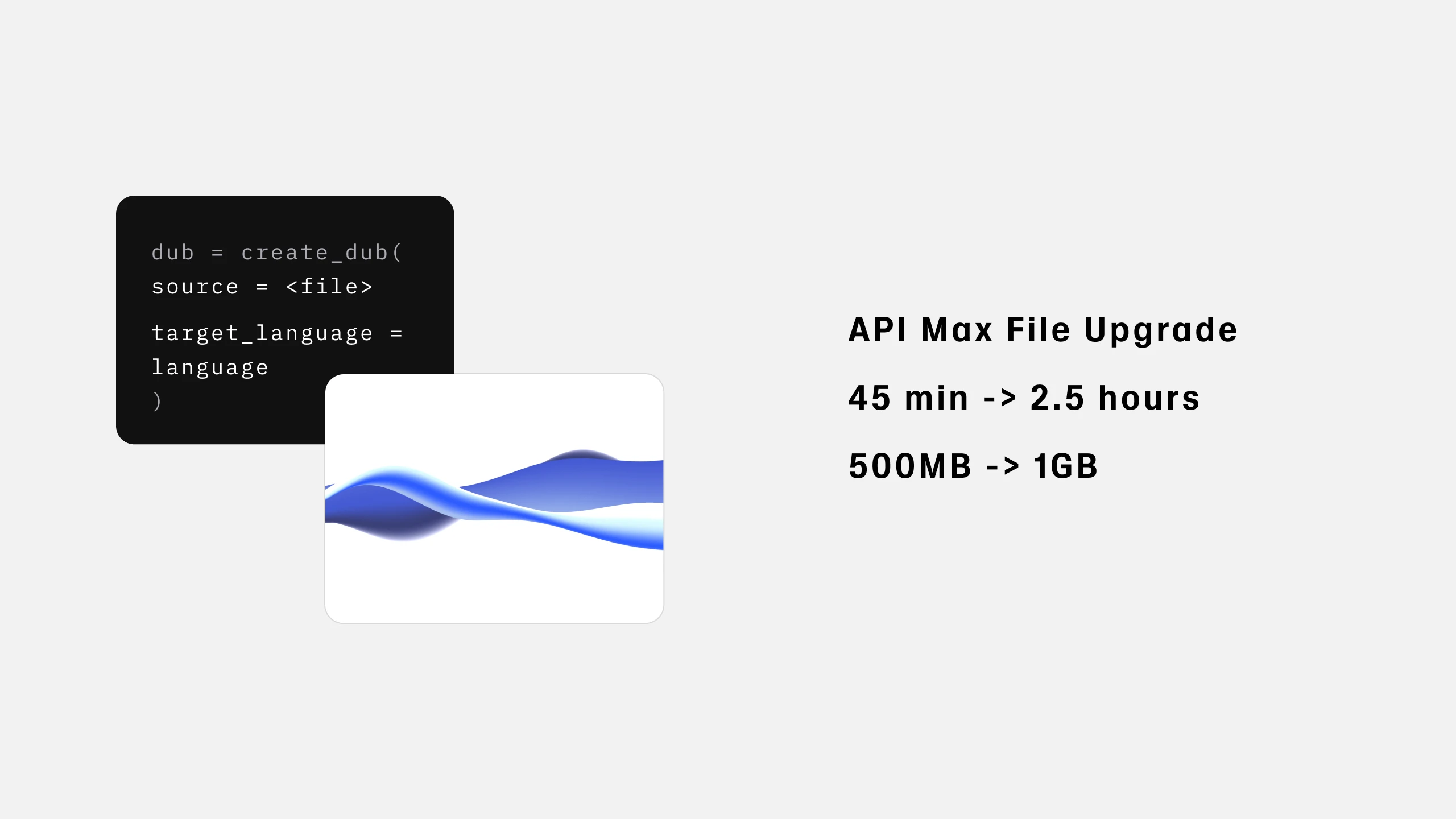
Dubbing API Max File Upgrade
We increased the max file size for a single call to our Dubbing API from 45 min -> 2.5 hours and 500MB -> 1GB
Phonemes are the basic building blocks for our linguistic communication, enabling us to form words to create sentences that encapsulate our thoughts and emotions. Unraveling the enigma of phonemes can give us a greater understanding of spoken language, its various components, and how these sounds unite to form words.
This blog will delve into a clear phoneme definition and then look at how an understanding of phonemes can support the linguistic development of second-language learners. Finally, we'll conclude by asking how AI voice generation tools like ElevenLabs can support the understanding of our phoneme definition and improve language acquisition.
Have you ever wondered why two words, like ‘cat’ and ‘cut,’ which only differ by one letter, sound so different? This is due to the concept of phonemes.
At its core, a phoneme is the smallest unit of sound that distinguishes one word from another in a particular language. Unlike letters, which represent individual sounds in written language, phonemes are the oral manifestations that give spoken words their distinctive identities. A word will usually have more than one phoneme in its construction.
For phoneme examples, consider the English words "pat" and "bat." The initial sounds /p/ and /b/ represent distinct phonemes because substituting one for the other changes the meaning of the word. The term 'phoneme' originates from the Greek word ‘sound,’ thus indicating its importance when conveying semantics through spoken expression.
Languages vary in their phonemic structures, and linguists classify phonemes into two categories: consonants and vowels. Consonants involve constriction or closure of airflow, creating distinct sounds like /p/, /t/, and /s/. Vowels, on the other hand, involve an open vocal tract and include sounds like /a/, /e/, and /i/. The intricate interplay of these phonemes gives rise to the rich tapestry of sounds within a language.
Within a language, phonemes may also have different phonemes known as allophones. Allophones are variations of a phoneme that do not change the meaning of a word. For instance, the aspirated and unaspirated pronunciations of the English /p/ in "pat" and "spat" are allophones. Recognizing these subtle variations is crucial for accurate pronunciation and comprehension.
All of this variation can be confusing, so phonemes across languages must be standardized for study. This is done by the International Phonetic Alphabet (IPA). These IPA symbols are distinct from alphabetic letters in written language.
This distinction is fundamental for understanding the phonetic environment. As a guide, IPA symbols help learners navigate different voices and pronounce words correctly when learning various tongues.
In the English language, there are 44 phonemes that include 24 consonants and 20 vowel sounds. These speech sounds serve as building blocks for forming words and conveying messages with clarity in this linguistic system.
Both English speakers and native speakers of other languages should have an understanding of phonemes and phonemic analysis so they can pronounce them accurately, communicate efficiently, and comprehend expansive vocabulary proficiently.
As we move around the world, different accents and dialects present additional phonemes or variations in pronunciation. This could include changes to how two consonants are uttered, which may not be found in other languages’ vocabulary. These regional pronunciations significantly affect spoken language comprehension - affecting word recognition as well as auditory comprehension using a particular language’s rules of articulation.
We see an array of different sound profiles when studying languages across the globe, each consisting of a distinct set of phonemes. How many phonemes are recognized within a language impacts how difficult the language is to learn.
Languages such as Rotokas and Pirah have only nine to eleven individual sounds, while others may include up to 141 audio elements. Russian, Hawaiian, Quileute Twana and Ditidaht are among those with fewer phonemes, offering learners less complexity than Lithuanian or Danish, which contain more contrasting phoneme components.
The use of certain variations can also change meanings within one language. In Icelandic, [kh] stands in contrast to [k], which is seen at the beginning of ‘kátur’ denoting cheerful versus ‘gátur’ referring here to riddles. Tonal languages add a further level of complexity. The different phonemes of different tones are easily recognized by native speakers of tonal tongues, whereas those whose given language is not tonal may struggle to tell them apart.
Learning new sounds can be challenging, especially when multiple graphemes are used to denote the same phoneme or if it’s unfamiliar. Certain phonemes like ‘th’ in English and a “rolled-r” in Spanish may even present an extra hurdle for learners. To tackle these obstacles successfully requires different learning strategies.
Yet understanding and embracing phonemes is invaluable for language learners. It aids in achieving native-like pronunciation and enhances listening comprehension. Language apps and interactive tools often leverage the concept of phonemes to provide targeted pronunciation practice, offering learners a practical approach to mastering the nuances of spoken language.
This technology is supplemented by the latest developments in AI voice generation. Human-like voice generator tools, like ElevenLabs, can rapidly convert written text into accurate spoken words with varying regional accents, creating audio files that are downloadable and reusable. This helps language students listen and mimic realistic pronunciation without access to a native teacher.
Whether delving into the phonetics of a new language or refining your native tongue, a solid understanding of phonemes is the key to mastering the art of effective and articulate expression. Yet an academic understanding of linguistics is not the only way we humans can acquire languages. We also learn through listening and mimicry. In this way, text-to-speech generation tools are invaluable in cultivating phonemic awareness and building an innate understanding of sound units, whole words, and the other different sounds that are naturally included in spoken communication.
Ultimately, the nuanced variations and subtle distinctions of phonemes contribute to the richness and diversity of linguistic expression. By grasping the concept of phonemes and their role in language acquisition, learners can embark on a journey to unlock the profound intricacies of spoken communication, using the latest in AI technology from ElevenLabs for support.
The smallest unit of sound, a phoneme, carries meaning and is used to differentiate between words. The one-sound difference found at the beginning of ‘hat’ versus ‘cat’ serves as an example.
Also known as allophones, multiple variants can be recognized collectively under a single sound or phoneme. For instance, English’s /k/ which appears at the beginning of ‘cat’, ‘kit,’ ‘scat,’ and ‘kit.’ Every word consists of various sounds that serve different purposes; these foundation stones for language recognition are separate phonemes.
Phonemes are the building blocks of any particular language. English consists of 21 consonant phonemes, 4 diphthongs, 8 vowels as well as 11 additional variations. These 44 distinct phonetic units play a major role in aiding understanding and promoting literacy by helping to decode words within language.
Teaching children phonemes can be done through using sound analogies and flashcards. Each card displays a word along with an image to support understanding. For example, the /a/ in ‘cat’ has been likened to a baby’s cry, while the /b/ of ‘ball’ is comparable to bouncing basketballs.
AI text-to-speech and voice generation tools are invaluable for teaching language learners consonant sounds, speech sounds, and the special pronunciation of a particular word.
By generating expertly pronounced language using AI tools like ElevenLabs, English language learners can listen carefully to the realistic pronunciation of a speech sound and then improve on their own pronunciation as a result.
In English, words are comprised of around 44 individual sounds, known as phonemes. Language consists of many unique and varying combinations of these distinct sounds that make up the pronunciation we use to communicate with one another.
The process of dividing words into phonemes, or their individual sounds, is imperative for new readers as it facilitates the association between written language and pronunciation, which can be applied to reading, spelling, and writing.

We increased the max file size for a single call to our Dubbing API from 45 min -> 2.5 hours and 500MB -> 1GB

AI-generated voiceover usage has doubled since integrating ElevenLabs